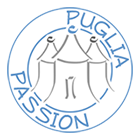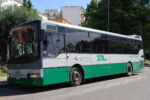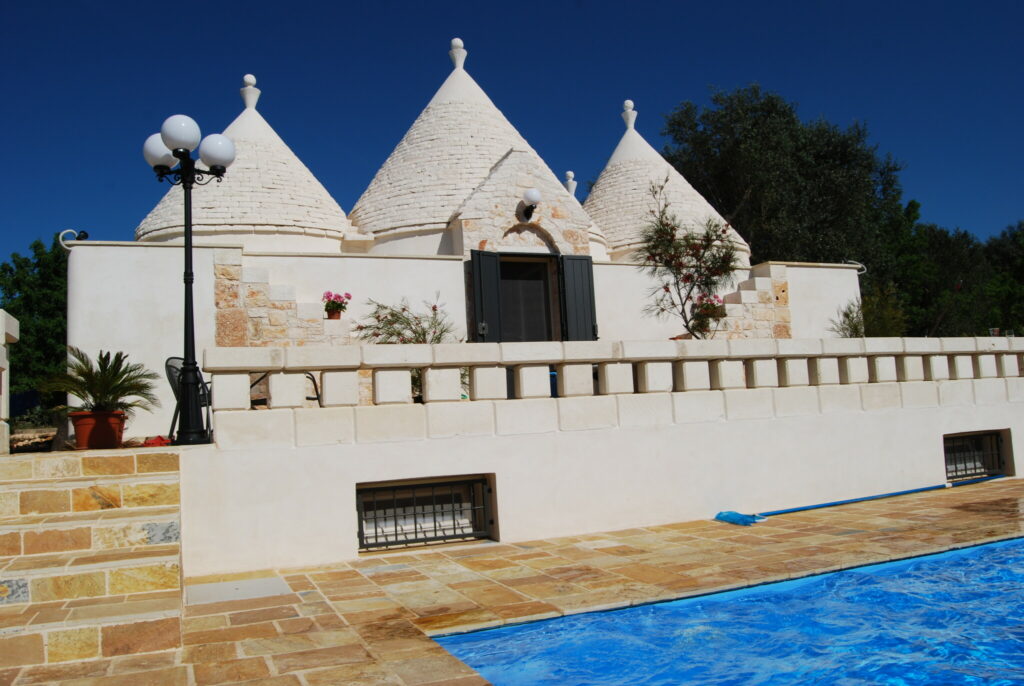

Monte Sant'Angelo is one of the two main Christian shrines in the Gargano and one of the most important in Europe. It has been a pilgrimage destination for centuries. The other main Gargano shrine is the much more recent centre dedicated to San (Padre) Pio at San Giovanni Rotondo. These two places are a few kilometres apart on the edge of the escarpment bounding the south side of the Gargano and are frequently visited jointly. The Gargano peninsula, the "spur on the heel of the boot" of Italy, is quite different in physical character from the rest of Puglia. It has a mountainous interior, much of it forested, with a coastline consisting of limestone headlands separating sandy beaches.
It is a town of nearly 15,000 people, perched on the side of the limestone escarpment at a height of over 800 metres above sea level, looking out over the Gulf of Manfredonia and almost directly above the city of Manfredonia, from where it is clearly visible. Its commerce is related mainly to food and agriculture, but also to meeting the needs of the many tourists and pilgrims who come to the Santuario di San Michele Arcangelo. The older area around the Santuario in the highest part of the town is an attractive area of narrow streets, arches and steps; however the newer parts of Monte Sant'Angelo are somewhat ugly, despite the stunning location.
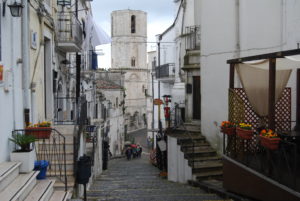
The Santuario is a complex of churches and altars set in large limestone caverns. It is the oldest shrine in Western Europe dedicated to St Michael the Archangel and is the main visitor attraction in Monte Sant'Angelo (the other main attractions are grouped nearby). It has been a UNESCO World Heritage Site since 2010, a designation linked with several other places in Italy which represent the legacy of the Longobardi (Lombard) rule in the pre-Norman era.
Towards the end of the 5th century AD, the cult of St. Michael the Archangel spread from the Middle East and Constantinople, where it was already well established, into the Gargano. The cave in the mountains where the shrine developed was already an established place of pagan worship. San Michele reputedly appeared three times there, in 490, 492 and 493 AD, promising to protect Siponto from its enemies and dedicating the cavern to Christian worship. This was duly done by the Bishop of Siponto and the church authorities, although since the "consecration" was according to the legend made by San Michele himself, this church is unique in that it has never been formally consecrated in the normal manner. It became a major shrine after the Longobardi replaced Byzantine rule in the area in the 7th and 8th centuries. The complex of buildings on the site was largely constructed in the 13th century under Swabian rule. The grotto became a destination for pilgrims and crusaders, a popular stopping off place en route to Jerusalem. Another reputed appearance by St Michael during a plague attack in 1656 increased even further the reputation of Monte Sant'Angelo.
The Santuario complex is located almost at the top of the hillside on which the town is built. It is open to visitors:
July – August: weekdays 7:30 at 19 and 30 and holidays from 07:00 at 20:00.
April, May and October: weekdays from 7:30 at 12:30 and holidays from 07:00 to 13:00 and from 14:30 to 20:00.
November – March: weekdays from 7:30 to 12:30 and from 14:30 to 18:00, and holidays from 07:00 to 13:00 and from 14:30 to 19:00.
There are frequent religious services when visiting may be restricted, and there are usually many visitors in groups, especially at weekends and on the special days of 29 September and 8 May. There is no charge to enter the Santuario, but you do have to pay a small amount to visit the museums inside. Photography is forbidden (the few on our site were taken with permission).
The main entrance is from Via Reale Basilica in the older part of the town. There is a small courtyard in front of the double arcaded entrance - this dates originally from the 13th century, but was modified many times, most recently in 1895. The left hand doorway depicts the history of the Santuario; it was made in bronze to commemorate the visit by Pope John Paul II in 1987.
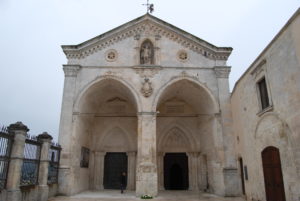
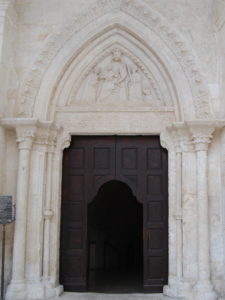
To the right of the courtyard is the octagonal campanile, built by the Angevin emperor Charles I, although previously it was a watch tower established by Frederick II; finished in 1282, the campanile was originally 40 metres high but later reduced to 27 metres, and has six bells, the largest made in 1666.
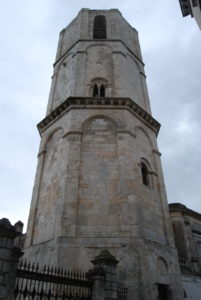
Through the entrance is a magnificent staircase going down to the grottoes, 86 steps, decorated with various statues, inscriptions etc. This was constructed in the 13th century to give access to the grotto churches below and is the main way in and out (NB there is a lift for those who need it). At the bottom of the stairs the entrance to the grotto churches themselves is via a 13th century portal with bronze doors made much earlier in Constantinople in 1076, donated by a rich family from Amalfi (who made similar gifts to other churches in Italy), depicting Old and New Testament scenes in 24 panels.
In the largest cavern is the Cappella del Santissimo Sacramento, decorated in an essentially Baroque style from the 17th century onwards. In a silver and glass case is a small marble statue of San Michele by Andrea Contucci, also known as Sansovino; it has been in the grotto since 1507, and is very much its symbol. Permission to make miniature reproductions of St. Michael was limited to a special class of local sculptors called sammecalère, who are responsible for the many variations on Contucci's original, each slightly different from the next. In a separate grotto off the main cavern is the oldest altar in the complex, dedicated to Madonna del Perpetuo Soccorso, Our Lady of Perpetual Help. In a separate cavern is the new Capella Penitenzia, which was constructed to celebrate the Third Millenium. The complex also contains two museums as well as various specialist chapels, offices and meeting rooms.
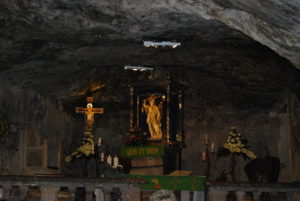
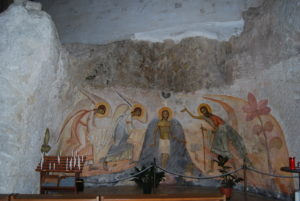

Beyond the Santuario entrance a short walk uphill takes you to the Castello. Recent evidence indicates this may have been the site of an Iron Age fort. The castle was originally built by Orso I, Bishop of Benevento and Siponto in the 9th century to defend the nearby Santuario. It was developed into a part of the defensive city wall system in the second half of the 11th century by the Normans, especially Roberto il Guiscardo. Subsequently, like many other castles in this part of Italy, it was extended by Frederick II to become part of the major defence system he created in Puglia. However, it was also a royal residence for his four wives, including Bianca Lancia di Torino, who gave birth there to Manfredi (who went on to play a major role in Italian history and to found Manfredonia).
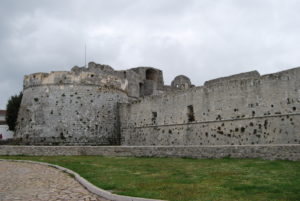
After the Angevins defeated the Swabian Manfredi at the battle of Benevento in 1236, they took control of the castle and used it mainly as a prison for aristocrats. Later under Aragonese rule in the 15th century, it was developed into its current form so as to be able to deal with new weapons such as gunpowder and played its part in defending the Gargano against the Turks. It subsequently passed though a series of ownerships, closely associated with the church, and was almost destroyed in the 19th century before being bought by the Commune of Monte Sant'Angelo in 1907. Since 1994, it has been well restored, with a series of interesting displays inside; open 9.30am - 1.00pm, 2.30pm-7.00pm every day, charge 5 euros. For no charge you can go across the main entrance bridge, view the outside of the fortress and enjoy the fantastic vista over the sea and inland.
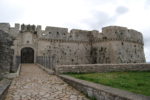
A few steps opposite the entrance to the Santuario is the third major historic and architectural feature of Monte Sant'Angelo. It consists jointly of the remains of La Chiesa di San Pietro; the baptistery known as San Giovanni in Tumba or La Tomba di Rotari (the Tomb of Rothari); and the mediaeval church of Santa Maria Maggiore. The group of buildings is open to the public only from Easter until mid October, 10.00am-1.00pm and 3.15pm-7.00pm; there is a (theoretically voluntary) charge of 1 euro to enter the site.
La Chiesa di San Pietro was built in the 12th century, the oldest church in this area, but evidence suggests that there was an even earlier church on its site. It was demolished in 1894, leaving only a few remains, in particular the dominant domed apse containing eleven niches symbolizing the Apostles - the bigger central niche belongs to San Pietro.
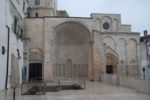
On the left of the apse of San Pietro is the entrance to San Giovanni in Tumba. This is popularly known as La Tomba di Lotari; however, this seems to be a misinterpretation of the term "tumba" meaning "dome" on an inscription inside. There is little evidence that the Lombard king is buried here at all, although he does seem to have expressed a wish for this to happen, and some ancient records say he actually was. It is nevertheless a reminder of the significance of the Longobardi (Lombards) in this area. Rotari, Duke of Brescia, became King of the Longobardi in 636. The Longobardi were militarily active (hence their special link with San Michele as a warrior Archangel). Rotari led numerous campaigns and brought much of Italy under Lombard rule as Byzantine power weakened. He is especially associated with an edict of 643 which provided written codification of Lombard law (previously based on oral traditions). This edict was also innovatory in many respects, including introducing monetary compensation as an alternative to revenge as a means of resolving disputes; and specific limitations on use of the death penalty. It is maybe a pity Rotari is apparently not buried here, but he seems someone worth knowing about anyway!
The building is quite complicated in structure - a rectangle supports an octagon which supports an elipse which supports a dome. It was mainly built in the 11th century, probably on an ancient burial site. There is an empty sarcophagus in the rock near the entrance. There are decayed frescoes on the walls, and various wall carvings and features which are of considerable specialist interest, notably a depiction of Christ being taken down from the cross based on an account by Nicodemus rather than any of the main gospel writers; and old testament scenes unusual in Christian churches. It is thought that this building may have been the original San Pietro, and when the (now demolished) church was built next door, the pre-existing building was incorporated as its battisteria and redesignated San Giovanni.
The third element of the San Pietro complex is La Chiesa Santa Maria Maggiore. This is the oldest church in Monte Sant'Angelo, and is regarded locally as the city's main church. There is evidence of a church on the site as long ago as 300AD, but the cuurent building dates from the 11th century, with major extensions and renovations in 1200 by Constanza d'Altavilla, the mother of Frederick II. The church is in Romanesque style, with three naves. There are Byzantine frescoes on the walls, and also one commemorating the visit of San Francesco d'Assisi in 1216.
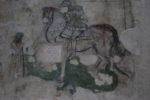
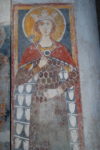
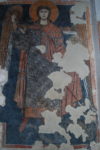
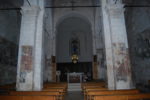
For those interested in churches for any reason, Monte Sant'Angelo has a lot on offer, not surprisingly. There are several in the older part of the city and can easily be visited, although they are frequently not open. One which can easily be seen in conjunction with a visit to the Santuario is La Chiesa della Madonna della Libera, located in a small courtyard through an arch immediately to the right of the Santuario main entrance. This is a small and attractive church, built in 1879 on the site of an ancient cemetery, and very well maintained to this day. As well as altars and wall decorations, the church contains statues of Sant'Anna and Santa Lucia.
Monte Sant'Angelo can easily be reached by car, leaving the autostrada A14 at Foggia or San Severo and going via San Giovanni Rotondo - roads in the Gargano generally are often narrow and winding, but this route is less "challenging" than the road up the side of the escarpment from Manfredonia. There is a large (pay) car park close to the Santuario and Castello.
There are (mainly SITA) bus links a few times a day with Foggia (railway station), Manfredonia (Piazza Marconi) and San Giovanni Rotondo. Buses from Foggia go via Manfredonia, and the trip from there up the escarpment is a pretty exciting 30 minutes or so. Until very recently the bus terminus in Monte Sant'Angelo was in the middle of the town at Piazza Duc d'Aosta, not too far from the main attractions. However, it has now been moved to Viale Kennedy, which is very inconveniently situated a long way from where you want to be. (NB This move, to reduce pollution in the town centre, is still controversial, so may be changed). From the new bus stop, go back to the roundabout, turn right and walk up the road for a couple of hundred metres, then turn left at the Post Office into Via Manfredi - then just keep walking steadily uphill for about 20/25 minutes until you reach the old town area. There is a minibus service which connects the bus terminus to the town centre and the old town, but we have not been able to find any reliable details of this.
